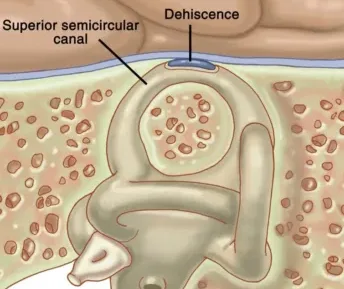Introducing the patient who can hear their eyeballs move and gets dizzy when they cough. Sound crazy?
The following are all symptoms of superior canal dehiscence:
- Being able to hear internal noises such as heartbeat, eye movement and blinking
- Autophony and/or own voice sounding distorted
- Vertigo triggered by loud sounds
- Vertigo/oscillopsia with physical strain such as coughing, sneezing, blowing the nose or lifting something heavy
- Aural fullness and/or hearing loss in the symptomatic ear
The mechanism
The inner ear has two functioning windows. The oval window allows soundwaves into the inner ear and the round window enables the release of sound and mechanical energy out of the inner ear. This is a hydraulically closed system.
In SCD there is a dehiscence or “third window” which alters the mechanical operation of this system. Sound energy can escape through the dehiscence resulting in a low frequency air-bone gap in hearing. Due to the increased sensitivity of the system, sound and pressure changes can also induced endolymph movement causing vertigo symptoms described above.
Identifying this condition
High-resolution CT imaging provides excellent sensitivity for SCD detection however may give a false impression of a dehiscence when the bone is simply thin but intact. Because the treatment of SCD is surgical, a highly specific test is needed to confirm the diagnosis and avoid false positives and subsequent unnecessary surgery.
Vestibular Evoked Myogenic Potentials (VEMPs) have been shown to be particularly valuable in identifying patients with SCD. Many studies have documented that the amplitude of the VEMP increases and the threshold decreases in SCD compared to VEMPs in healthy subjects. A low-frequency air-bone gap or pseudo-conductive hearing loss is also a well-documented phenomenon in SCD.
With this knowledge we have developed a test battery to assist with accurately identifying SCD which includes:
- Audiometric bone-conduction testing performed in the low frequencies
- Air-conduction cVEMP threshold seeking
- Air-conduction oVEMP testing and threshold seeking
- Air-conduction oVEMP testing at 4kHz
If requested, or if we suspect SCD, we will perform these additional tests as well as the standard test battery in one session.
References:
Curthoys, I. S., Burgess, A. M., Manzari, L., & Pastras, C. J. (2022). A Single Fast Test for Semicircular Canal Dehiscence-oVEMP n10 to 4000 Hz-Depends on Stimulus Rise Time. Audiology Research, 12(5), 457–465. https://doi.org/10.3390/audiolres12050046
Ho, M. L., Moonis, G., Halpin, C. F., & Curtin, H. D. (2017). Spectrum of Third Window Abnormalities: Semicircular Canal Dehiscence and Beyond. AJNR. American Journal of Neuroradiology, 38(1), 2–9. https://doi.org/10.3174/ajnr.A4922
Noij, K. S., & Rauch, S. D. (2020). Vestibular Evoked Myogenic Potential (VEMP) Testing for Diagnosis of Superior Semicircular Canal Dehiscence. Frontiers in Neurology, 11, 695. https://doi.org/10.3389/fneur.2020.00695
Palma Diaz, M., Cisneros Lesser, J. C., & Vega Alarcón, A. (2017). Superior Semicircular Canal Dehiscence Syndrome – Diagnosis and Surgical Management. International Archives of Otorhinolaryngology, 21(2), 195–198. https://doi.org/10.1055/s-0037-1599785
Waldeck, S., Lanfermann, H., von Falck, C., Froelich, M. F., Chapot, R., Brockmann, M., & Overhoff, D. (2022). New classification of superior semicircular canal dehiscence in HRCT. PloS One, 17(1), e0262758. https://doi.org/10.1371/journal.pone.0262758

